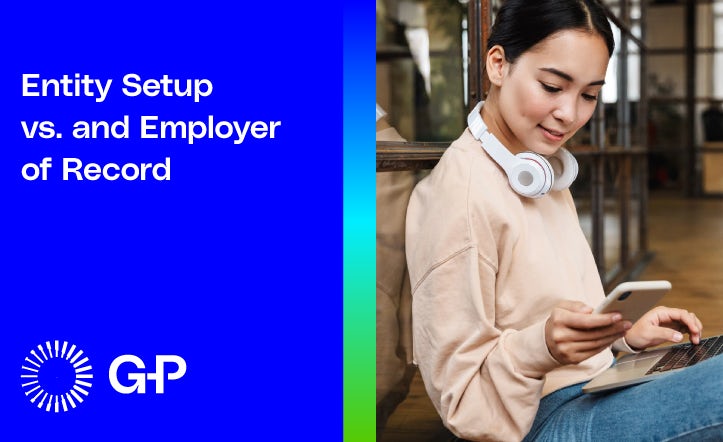오늘날의 경제 환경에서 기업들은 비즈니스 성공에 대한 접근 방식을 재평가해야 하는 과제가 점점 더 커지고 있습니다. 중소기업과 중소기업 모두 인재 부족과 같은 일반적인 문제를 해결하기 위해 글로벌 확장으로 인한 회복력과 기회로 전환하고 있습니다. 글로벌 불확실성에도 불구하고 73고위 경영진의 %가 년 성장을 우선시하고 2024있으며, 이는 글로벌 사고방식이 번영을 원하는 조직에 매우 중요하다는 것을 입증합니다. 또한 39고용 리더의 %는 년 내내 고용에 대한 재정적 약속을 늘릴 계획2024입니다.
그러나 새로운 시장 진입은 비용이 많이 들고 시간이 많이 소요될 수 있습니다. 그리고 글로벌 채용 시장이 새로운 글로벌 사고방식과 AI 기반 혁신의 부상과 같은 추세에 힘입어 계속 변화함에 따라, 기업은 선제적인 접근 방식을 취하고 구직자들에게 유리한 환경을 조성하여 성장을 준비해야 합니다.
그렇기 때문에 많은 기업들이 채용, 채용 및 규정 준수와 같은 HR 기능을 간소화할 수 있는 대안을 찾고 있습니다. 인력을 신속하게 확장하고자 한다면 EOR 또는 글로벌 PEO와 협력하여 시간과 비용을 절약하면서 HR 요구를 효율적으로 관리할 수 있습니다.
하지만 HR에서 EOR과 PEO는 무엇을 의미할까요? PEO와 EOR 모델의 차이점은 무엇입니까? 각 모델의 이점과 이러한 서비스가 기업이 인재를 유치하고 유지하는 데 어떻게 도움이 될 수 있는지 살펴보겠습니다.
고용전문회사(PEO)란?
전문 고용주 조직(PEO)은 고용하는 특정 관할권에서 이미 자체 등록 법인을 보유하고 있는 다른 회사와 개인을 공동 고용하는 회사입니다. PEO는 회사에 급여, 복리후생, 세금 신고, 근로자 보상, 사업 보험 및 기타 HR 책임을 포함한 다양한 HR 서비스를 제공할 수 있습니다. PEO는 복리후생 관리 비용을 줄이고 급여 운영을 간소화할 수 있는 전문 지식을 제공합니다. PEO는 공동 고용 모델을 활용하므로 PEO와 고용주는 고용된 개인에 대한 책임을 공유합니다.
현재 미국에만523 PEO가 있으며, 년에 PEO 업계의 백만 명의 작업장 직원이 미화 305십억 2022달러의 급여를 받았습니다.4.5 PEO는 다음과 같은 특정 회사 책임을 맡습니다.
- 급여 및 세금
- 복리후생 관리
- 규정 준수 지원
- HR 서비스 및 관리
- 산재보상보험
PEO 비용은 얼마입니까? PEO와 협력하는 비용은 회사의 규모와 필요한 특정 HR, 법률, 세금, 회계 및 고객 서비스에 따라 달라집니다. 일반적으로 PEO는 매월 각 직원에 대해 고정 수수료를 부과하거나 회사 총 급여의 미리 결정된 비율을 수집하여 수수료를 설정합니다.
HR 요구 사항을 관리하는 옵션을 탐색하는 경우 ASO(관리 서비스 조직) 서비스도 이용할 수 있습니다. ASO 대 PEO란 무엇입니까? PEO와 ASO는 모두 HR 관련 업무를 수행하지만, PEO는 공동 고용주 역할을 하지만 ASO는 그렇지 않습니다. ASO는 급여, 복리후생 또는 근로자 보상을 직접 제공하지 않지만, 가능한 제공자를 찾는 데 도움이 될 수 있습니다.
EOR이란 무엇입니까?
반면 글로벌 기록상 고용주(EOR)는 급여 및 복리후생을 포함한 PEO의 모든 기능을 처리하지만, 유일한 법적 고용주 역할을 하며 해당 국가에 법인이 없는 회사를 지원합니다. EOR은 법적 책임을 크게 줄이면서 모든 HR, 급여 및 규정 준수 기능을 처리하며, 국내에 현지 법인을 설립할 필요 없이 회사가 해외에서 고용할 수 있도록 합니다.
EOR은 다음을 포함한 모든 HR 관련 작업을 처리하여 일상적인 운영을 간소화합니다.
- 온보딩 및 오프보딩
- 고용 계약 생성
- 원천징수 및 신고
- 급여
- 현지 법률 준수
- 복리후생 관리
EOR 비용은 얼마입니까? EOR 비용은 직원 수, 제공되는 서비스 유형 및 위치 등 몇 가지 주요 요인에 따라 달라집니다. 일부 EOR에는 직원당 고정 수수료가 부과되는 반면, 다른 서비스 제공업체는 계약 위치와 기간에 따라 비용을 결정합니다.
기록상 고용주 대 PEO: 차이점은 무엇입니까?
PEO와 EOR의 차이점은 무엇입니까? 두 서비스 모두 회사의 HR 기능을 처리하지만 비용, 구조, 규모 및 범위 면에서는 다릅니다. 전문 고용주 조직(PEO)과 달리 G-P의 EOR 솔루션은 글로벌 지침, 규정 준수 및 위험 관리를 제공하므로 보다 안심하고 전략적 성장에 집중할 수 있습니다. 기록상 고용주 서비스와 PEO의 주요 차이점은 다음과 같습니다.

| 기록상 고용주(EOR) | 고용전문회사(PEO) | |
|---|---|---|
| 고용주 구조 | 직접 고용주 | 공동 고용주 |
| 직원에 대한 법적 책임 | 예 - 위험을 완화합니다. | 아니요 — 주식 책임 |
| 범위 | 전체 주기 고용 | HR 관리 |
| 비용 | 장기 비용 절감 증가 | 장기적인 비용 절감 최소화 |
| 준법 | 법인 필요 없음 | 현지 법인 필요 |

1. PEO와 달리 EOR은 법적 고용주 역할을 합니다.
EOR과 PEO 간의 가장 중요한 차이는 고용주 구조입니다. EOR은 법적 고용주 역할을 하며 회사를 대신하여 근로자를 고용합니다. 전문 고용 조직(PEO)은 공동 고용 구조로, 이는 회사도 직원에 대해 법적 책임을 진다는 것을 의미합니다.
2. EOR은 전략적 지침과 시장 통찰력을 제공합니다.
PEO는 일반적으로 현지 고용 패키지에 포함된 국가별 복리후생을 조정합니다. 그러나 EOR은 목표 시장에서 직원의 기대치에 관한 지침을 제공함으로써 한 걸음 더 나아가고 있습니다. 여러 관할권의 고용 고려 사항에 대한 이러한 전략적 조언을 통해 기업은 글로벌 확장 전략에 대해 정보에 입각한 결정을 내릴 수 있습니다.
3. PEO는 확립된 법인을 요구합니다.
PEO는 회사가 설립된 법인을 보유하도록 요구하는 반면, EOR은 이미 법적 글로벌 입지를 갖추고 있으며 회사가 국내 법인 또는 현지 전문지식을 보유할 것을 요구하지 않는 파트너입니다.
4. EOR은 글로벌 규정 준수를 보장합니다.
글로벌 EOR은 국제 노동법을 지속적으로 검토하여 현지, 주 및 국가 규정을 충족하고 최신 상태로 유지합니다.
PEO는 덜 포괄적인 접근 방식을 가지고 있으며 일반적으로 특정 영역에서 규정을 준수하는 방법에 대한 지침과 지침을 제공하지만, 요건을 충족하기 위해 필요한 조치를 취하는 것은 비즈니스 자체에 달려 있습니다.
기록상 고용주 서비스 대 PEO: EOR 솔루션을 선택해야 하는 이유
이미 대상 국가에 법인이 있고 특정 HR 운영을 간소화하고 직원에게 더 나은 혜택을 제공하고자 하는 경우, PEO와 협력하는 것이 더 비용 효과적인 대안이 될 수 있습니다. 그러나 EOR은 새로운 법인을 설립하는 것보다 훨씬 빠르고 저렴합니다.
글로벌 시장에 접근할 수 있는 능력은 기업이 EOR과 협력할 때 얻을 수 있는 주요 이점입니다. EOR을 통해 기업은 몇 개월이 아닌 몇 분 만에 전 세계 모든 곳에서 숙련된 직원을 원활하게 고용할 수 있습니다.
G-P의 기록상 고용주(EOR) 솔루션으로 180여 개국에서 인재를 채용하십시오.
G-P는 글로벌 기록 고용주(EOR) 모델을 만들어 새로운 법인을 설립하지 않고도 글로벌 성장을 위한 빠르고 쉬운 솔루션을 가능하게 했습니다. PEO와 달리, 당사의 엔드 투 엔드 EOR 솔루션은 지침, 규정 준수 및 위험 관리를 제공하므로 안심하고 비즈니스를 성장시킬 수 있습니다.
당사의 1위 Global Growth Platform™은 다음을 간소화하고 자동화합니다.
- 온보딩 및 오프보딩. 당사의 HR 전문가는 신입사원을 신속하게 교육하고, 현지 법률을 준수하며, 주의하여 오프보딩을 처리할 수 있도록 온보딩을 간소화합니다.
- 대량 온보딩. 당사의 대량 온보딩 기능을 통해 G-P의 고용 솔루션 계정 소유자는 대규모 온보딩을 처리하거나 계약업체를 풀타임 직원(FTE)으로 쉽게 대량 전환할 수 있습니다.
- 계약 생성 및 맞춤화. 계약을 마무리하는 데는 시간이 많이 소요될 수 있습니다. 플랫폼 내 고용 계약 생성기로 몇 번의 클릭만으로 법률 준수 계약을 쉽게 작성할 수 있습니다. 또한 플랫폼을 통해 직접 계약 템플릿 사용자 지정을 요청하여 필요에 가장 적합한 계약을 얻을 수 있습니다.
- 복리후생 관리. 년에 50% 이상의 HR 전문가2024들이 신체적 및 정서적 건강을 개선하기 위해 더 많은 혜택에 투자하는 것을 최우선으로 여깁니다. 모든 국가별 요건을 충족하는 경쟁력 있는 복리후생 패키지를 신속하게 제공하여 최고의 인재를 유치합니다.
숙련된 기술 인재를 찾고 있는 스타트업이든, 새로운 시장으로 진출하는 대기업이든, G-P와 협력하여 전 세계 어디에서나 직원과 계약업체를 찾고, 고용하고, 관리하십시오.












